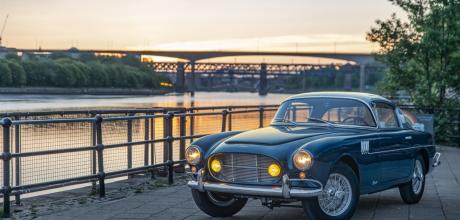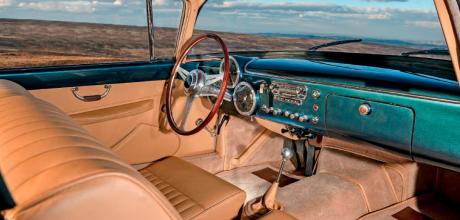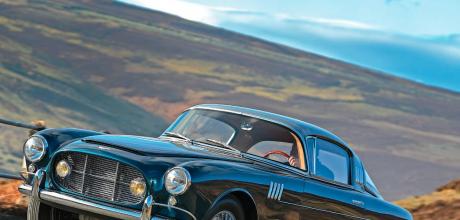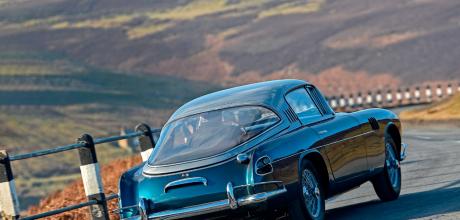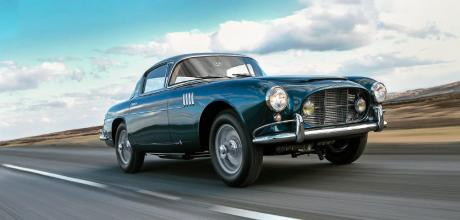Ordered new by a Belgian monarch, this sole surviving Vignale-bodied Aston Martin DB2/4 is back on form after decades in the doldrums.
The all too-common plight of the show car and the one-off special is perfectly encapsulated in the rather sad story of chassis number LML/802, a Vignale-bodied Aston Martin DB2/4.
WHEN FELTHAM MET TURIN
Driving the sole surviving Vignale-bodied Aston Martin after an exacting restoration
Custom-built at the behest of 25-year-old King Baudouin of Belgium in the mid-1950s – doubtless at huge expense – it was reduced to the level of a discarded trinket by the beginning of the 1960s. Once the height of Turin chic, LML/802 was already, even then, the product of another era: a rapidly ageing, buxom show queen – too much jewellery, too much make-up – in an age of clean, flat-chested ’60s purity. As the smooth, simple, rounded Italian shapes of the early ’50s evolved to reflect the public fascination with all things erican and ‘jet age’, this Vignale-bodied Aston demonstrates the hall of mirrors that car styling had become. It was just a phase, of course, but one embraced by Alfredo Vignale (and his in-house stylist, Giovanni Michelotti) with more relish than most, which was perhaps one of the reasons why Vignale lost the patronage of Ferrari – in favour of Pinin Farina – in the second half of the ’50s.
Whatever the politics, it was still a time when the er elements of European royalty were powerfully attracted to the coachbuilding workshops of Turin, none more so than Leopold III of Belgium, who, along with his equally enthusiastic consort, Princess Lilian, ordered five one-off coachbuilt Ferraris between 1953 and ’68. Lilian was Baudouin’s stepmother: Princess Astrid of Sweden, his biological mother, had died in a car accident in 1935 when the king crashed his new Packard convertible into a tree on the banks of Lake Lucerne.
After 1945, Leopold III was not very popular in Belgium, where it was felt he had acquiesced to the Nazis a little too readily. In the face of civil unrest he abdicated in favour of his 21-yearold son, Baudouin, in 1951. Once less in the public eye, the former king probably felt more able to indulge in exotic cars. The most famous of these was an all-black roadgoing Ferrari 375 Plus Cabriolet by Pinin Farina, although arguably the most beautiful was the special 330GTC built for the princess in 1968.
Not that the tall, bespectacled Baudouin was exactly immune to the charms of expensive motor cars. He had grown up around his father’s Bugattis (there’s a family snap of him sitting in a Type 52 ‘Baby’) and he is known to have owned a Porsche 550 and various Maseratis, although he was latterly associated with rather more statesmanlike vehicles: a Mercedes 600 Pullman, clap-door Lincoln and a variety of Cadillacs are all attributed to him. The Belgians have always had a strong allegiance to American cars.
Why he chose an Aston Martin – rather than a Ferrari or a Maserati – as the basis for his ‘statement’ car is hard to fathom at a distance of almost 70 years. But it was a legitimate enough choice, given that the Aston name was coming to greater prominence in racing and the DB2/4 was acknowledged to be one of the world’s best and fastest production grand touring cars. The link with Vignale is obvious because the body of his stepmother’s recently delivered Ferrari 250GT coupé had been created at the famous workshops on the Via Cigliano, Turin.
Designed by the prolific Michelotti, it was to be the final Vignale-bodied Ferrari of the 1950s. The princess, accompanied by Formula One World Champion Nino Farina, had even visited the carrozzeria to see it being built. LML/802 was one of a dozen left-hand-drive DB2/4 rolling chassis supplied by the Feltham works to European coachbuilders. Eight of these are attributed to Bertone, but Graber, Touring, mano and Ghia also did one each, which makes 14 special-bodied DB2/4s, by my sums, including the two Vignales – a twin of the Baudouin Vignale DB2/4 was also built, for a French customer, but is now presumed lost. Powered by the latest 140bhp 3-litre engine, LML/802 had the longer of the optional axle ratios. The factory chassis card only notes that the wire wheels are ‘partially chromed’. The body, hand-beaten from aluminium with an ash frame, was six months in the making and the king took delivery in March 1955. Vignale used the car in its advertising, describing the Aston as: ‘A two-seater coupé provided to a high European personality.’ Just a month earlier, Baudouin had acquired a standard 3-litre DB2/4, supplied by Belgian concessionaire Mannes but delivered to the the factory DB2/4 ran ‘CD’ diplomatic plates. While he apparently kept the standard car for decades (the first change of ownership is recorded as being in 1989), the Vignale DB2/4 fell out of favour much more rapidly: it was sold at an indeterminate point in the late 1950s to palace aide TR Mottershead. Nothing much is known of this character, other than the fact that he stored the car in Moselle, France. Here a man called James Toth enters the story. As an American solider working for NATO in Paris, Toth later discovered the Vignale in a back-street garage. Having captured LML/802, he managed to do terminal harm to both its original engine and its replacement in fairly short order, before giving up and selling the non-running DB2/4 to an army captain. Period black-and-white photographs show the Vignale Aston Martin less its front bumper at this point, and in a single-tone colour scheme. America – and the inevitable V8 conversion – beckoned, and from there it was a relatively short trip to the breaker’s yard for LML/802, whose brief moment of fame had long been forgotten. Then, at some point in the early 1990s, the Vignale Aston’s luck began to improve. It was rescued from a scrapyard in Virginia, still fitted with a Pontiac V8 engine and rear axle, by one Roland Wommack. In the middle of the decade, Wommack sold the car to Bob Fountain of the Aston Workshop in Beamish, County Durham. The Italian DB2/4 then languished some more after Fountain’s original idea of selling the car as a project proved tricky: one-offs tend to excite historians, but not paying customers. In the age of the internet the full significance of the Vignale soon dawned, however, and it appeared to Fountain that the only proper thing to do was restore the car with or without a buyer lined up. The good news was that the body and the chassis were remarkably sound, requiring only localised repairs, and most of the important unique brightwork had survived. The bad news was that the interior of the car was largely missing and had to be recreated from period photographs, and this, predictably, was by far the trickiest part of the restoration.
The all too-common plight of the show car and the one-off special is perfectly encapsulated in the rather sad story of chassis number LML/802, a Vignale-bodied Aston Martin DB2/4.
WHEN FELTHAM MET TURIN
Driving the sole surviving Vignale-bodied Aston Martin after an exacting restoration
Custom-built at the behest of 25-year-old King Baudouin of Belgium in the mid-1950s – doubtless at huge expense – it was reduced to the level of a discarded trinket by the beginning of the 1960s. Once the height of Turin chic, LML/802 was already, even then, the product of another era: a rapidly ageing, buxom show queen – too much jewellery, too much make-up – in an age of clean, flat-chested ’60s purity. As the smooth, simple, rounded Italian shapes of the early ’50s evolved to reflect the public fascination with all things erican and ‘jet age’, this Vignale-bodied Aston demonstrates the hall of mirrors that car styling had become. It was just a phase, of course, but one embraced by Alfredo Vignale (and his in-house stylist, Giovanni Michelotti) with more relish than most, which was perhaps one of the reasons why Vignale lost the patronage of Ferrari – in favour of Pinin Farina – in the second half of the ’50s.
Whatever the politics, it was still a time when the er elements of European royalty were powerfully attracted to the coachbuilding workshops of Turin, none more so than Leopold III of Belgium, who, along with his equally enthusiastic consort, Princess Lilian, ordered five one-off coachbuilt Ferraris between 1953 and ’68. Lilian was Baudouin’s stepmother: Princess Astrid of Sweden, his biological mother, had died in a car accident in 1935 when the king crashed his new Packard convertible into a tree on the banks of Lake Lucerne.
After 1945, Leopold III was not very popular in Belgium, where it was felt he had acquiesced to the Nazis a little too readily. In the face of civil unrest he abdicated in favour of his 21-yearold son, Baudouin, in 1951. Once less in the public eye, the former king probably felt more able to indulge in exotic cars. The most famous of these was an all-black roadgoing Ferrari 375 Plus Cabriolet by Pinin Farina, although arguably the most beautiful was the special 330GTC built for the princess in 1968.
Not that the tall, bespectacled Baudouin was exactly immune to the charms of expensive motor cars. He had grown up around his father’s Bugattis (there’s a family snap of him sitting in a Type 52 ‘Baby’) and he is known to have owned a Porsche 550 and various Maseratis, although he was latterly associated with rather more statesmanlike vehicles: a Mercedes 600 Pullman, clap-door Lincoln and a variety of Cadillacs are all attributed to him. The Belgians have always had a strong allegiance to American cars.
Why he chose an Aston Martin – rather than a Ferrari or a Maserati – as the basis for his ‘statement’ car is hard to fathom at a distance of almost 70 years. But it was a legitimate enough choice, given that the Aston name was coming to greater prominence in racing and the DB2/4 was acknowledged to be one of the world’s best and fastest production grand touring cars. The link with Vignale is obvious because the body of his stepmother’s recently delivered Ferrari 250GT coupé had been created at the famous workshops on the Via Cigliano, Turin.
Designed by the prolific Michelotti, it was to be the final Vignale-bodied Ferrari of the 1950s. The princess, accompanied by Formula One World Champion Nino Farina, had even visited the carrozzeria to see it being built. LML/802 was one of a dozen left-hand-drive DB2/4 rolling chassis supplied by the Feltham works to European coachbuilders. Eight of these are attributed to Bertone, but Graber, Touring, mano and Ghia also did one each, which makes 14 special-bodied DB2/4s, by my sums, including the two Vignales – a twin of the Baudouin Vignale DB2/4 was also built, for a French customer, but is now presumed lost. Powered by the latest 140bhp 3-litre engine, LML/802 had the longer of the optional axle ratios. The factory chassis card only notes that the wire wheels are ‘partially chromed’. The body, hand-beaten from aluminium with an ash frame, was six months in the making and the king took delivery in March 1955. Vignale used the car in its advertising, describing the Aston as: ‘A two-seater coupé provided to a high European personality.’ Just a month earlier, Baudouin had acquired a standard 3-litre DB2/4, supplied by Belgian concessionaire Mannes but delivered to the the factory DB2/4 ran ‘CD’ diplomatic plates. While he apparently kept the standard car for decades (the first change of ownership is recorded as being in 1989), the Vignale DB2/4 fell out of favour much more rapidly: it was sold at an indeterminate point in the late 1950s to palace aide TR Mottershead. Nothing much is known of this character, other than the fact that he stored the car in Moselle, France. Here a man called James Toth enters the story. As an American solider working for NATO in Paris, Toth later discovered the Vignale in a back-street garage. Having captured LML/802, he managed to do terminal harm to both its original engine and its replacement in fairly short order, before giving up and selling the non-running DB2/4 to an army captain. Period black-and-white photographs show the Vignale Aston Martin less its front bumper at this point, and in a single-tone colour scheme. America – and the inevitable V8 conversion – beckoned, and from there it was a relatively short trip to the breaker’s yard for LML/802, whose brief moment of fame had long been forgotten. Then, at some point in the early 1990s, the Vignale Aston’s luck began to improve. It was rescued from a scrapyard in Virginia, still fitted with a Pontiac V8 engine and rear axle, by one Roland Wommack. In the middle of the decade, Wommack sold the car to Bob Fountain of the Aston Workshop in Beamish, County Durham. The Italian DB2/4 then languished some more after Fountain’s original idea of selling the car as a project proved tricky: one-offs tend to excite historians, but not paying customers. In the age of the internet the full significance of the Vignale soon dawned, however, and it appeared to Fountain that the only proper thing to do was restore the car with or without a buyer lined up. The good news was that the body and the chassis were remarkably sound, requiring only localised repairs, and most of the important unique brightwork had survived. The bad news was that the interior of the car was largely missing and had to be recreated from period photographs, and this, predictably, was by far the trickiest part of the restoration.


